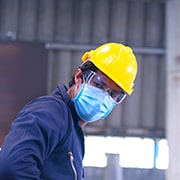 Naturally you care about the health and safety of your employees, and don’t need a federal agency to tell you that you should be concerned. Still, it’s helpful to know what the overall position of the Occupational Health and Safety Administration’s (OSHA) is on COVID-19. In a recent “alert,” OSHA urged employers to take the following three steps:
Naturally you care about the health and safety of your employees, and don’t need a federal agency to tell you that you should be concerned. Still, it’s helpful to know what the overall position of the Occupational Health and Safety Administration’s (OSHA) is on COVID-19. In a recent “alert,” OSHA urged employers to take the following three steps:
- Assess the hazards to which workers may be exposed,
- Evaluate the risk of exposure, and
- Select, implement and ensure workers use controls to prevent exposure.
These steps fall under OSHA’s overall requirement that employers “provide a workplace free from serious recognized hazards.”
OSHA’s List
If you think you’ve already considered every possible workplace safety measure, take a look at the following list of OSHA tips — you may be surprised by what you’ve missed:
Distancing
- Practice physical distancing even if employees show no signs or symptoms of infection.
- Move workstations farther apart to create social distancing.
Disinfecting
- Screen workers before they enter the workplace.
- Allow workers to wear face coverings when entering, during the workday, and when exiting the workplace and while working at drive-thru windows.
- Promote regular handwashing and place handwashing signs in workplace restrooms.
- Disinfect all work surfaces and equipment regularly.
- Use cleaning chemicals approved to disinfect against COVID-19.
- Discourage workers from sharing tools and equipment.
- Avoid the sharing of desks and phones.
- Clean vehicles shared by drivers and riders, including door handles.
- Avoid direct hand-off of takeout or curbside orders.
- Train workers to use, wear, store and dispose of personal protective equipment (PPE).
- Instruct employees to wash their hands before or after touching masks, gloves and other PPE.
- Encourage workers to monitor their health for symptoms of infection.
- Encourage workers to report any issues about safety and health and develop a process to address their concerns.
- Encourage sick workers to stay home.
- Disinfect the workstation and tools of any employee who becomes ill with COVID-19
Communicating
- Promote confidence with clear communications.
- Use multiple languages to effectively communicate with all workers.
Stay current on public health recommendations.
Post OSHA’s 10 steps poster to reduce exposure (get a copy at: osha.gov/Publications/OSHA3994.pdf
Note an important caveat to OSHA’s advice about disinfection practices: Never mix cleaning products that contain bleach and ammonia. When combined, those chemicals yield a toxic gas (chloramine) that can cause severe health problems.
Dealing With Resistance
In general, it’s reasonable to expect employees to welcome your safety measures. However, some workers may be annoyed by the restrictions — for example, being required to wear a mask. What happens if an employee violates a policy? Establish procedures for handling such violations, including whether you’ll provide warnings and impose progressively stronger sanctions following each incident.
The reasonableness of your organization’s safety requirements can be tested against recommendations by the Centers for Disease Control (CDC). The CDC currently recommends “that everyone wear cloth face coverings when leaving their homes, regardless of whether they have fever or symptoms of COVID-19.” However, this doesn’t mean masks should be worn constantly in every work setting. Before issuing mask instructions to employees, weigh the risks.
For example, if wearing a mask causes safety goggles to fog up and makes operating a machine unsafe, it may make sense for workers to remove masks while performing that job. Or if wearing a mask aggravates an employee’s existing medical condition, you’ll probably need to allow the employee to work without a mask — or work from home.
Final Thoughts
Every set of rules comes with those who want to flaunt them because they don’t recognize the need or they routinely resist authority. Try to issue workplace safety rules with a strong dose of employee education about why the rules are necessary and how they’ll be enforced. You’re likely to have fewer scofflaws to contend with.

